|
 |
Emile Friant
|
|
French Realist Painter, 1863-1932, Was a French painter. With a naturalist style Emile Friant painted quotidian scenes involving people. His creations are characterized by the photographic realism of the human skin portions, and a less defined portrayal of the rest of the scene. |
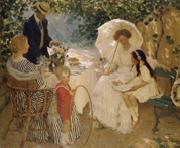 |
E.Phillips Fox
|
|
Australian Naturalist Painter, 1865-1915
Australian painter and teacher. From 1878 to 1886 he trained at the National Gallery of Victoria Art Schools, Melbourne, and in 1887 left to study in Europe. In Paris he attended the Academie Julian and was taught by Jean-Leon Gereme at the Ecole des Beaux-Arts and by the American artist T. Alexander Harrison (1853-1930). He was involved with the plein-air artists at Etaples, Pas-de-Calais, and in Brittany and also visited Giverny, where from 1883 Monet was living. By 1890 he had moved to England, to the artists' colony at St Ives, Cornwall. In 1892 he returned to Melbourne where he chiefly painted portraits and landscapes. He was a member of the Victorian Artists' Society, exhibiting with them between 1892 and 1900. In 1893 he established the lively Melbourne Art School with Tudor St George Tucker (1862-1906). There an academic training coupled with a modified Impressionist technique was taught, as can be seen in Fox's painting the Art Students . In 1901 he left for London, having been commissioned by the Trustees of the National Gallery of Victoria to paint the Landing of Captain Cook at Botany Bay. After his marriage in 1905 to the artist Ethel Carrick, he and his wife settled in Paris and remained there until 1913. |
 |
e. j. f. bendemann
|
|
Eduard Julius Friedrich Bendemann (3 December 1811, Berlin - 27 December 1889, Dusseldorf) was a German painter.
Bendemann was born in Berlin. His father, Anton Heinrich Bendemann, a Jewish banker, monitored his education closely; it was one that would have naturally led him to some sort of technical occupation, but his talent and propensity towards art resulted in his being allowed to pursue other interests. His mother Fanny Eleonore Bendemann nee von Halle, also a daughter of the Jewish banker Joel Samuel von Halle.
After he completed elementary school he enrolled in the Wilhelm von Schadow's School in Dusseldorf. In 1830 he went on a school trip to Italy. After a series of jobs, among them with Boas and Ruth, his talent as an artist began to show, especially with his very large 1832 painting titled, The Sad Jews of Babylon which was featured in the Berlin art exhibition. The picture garnered a great deal of attention, which was in part due to the deep and simple feeling and the noble composition of the piece (museum in Cologne). Bendemanns second picture: The Two Girls at the Well (1832), was acquired by the North Rhine-Westphalia art association.
Soon thereafter followed Jeremias on the Ruins of Jerusalem for which the artist received a medal in Paris in 1837. This painting was for the most part about the progress of the Jews in Babylon. (Royal Palace in Hanover). His best known work is The Harvest.
The artist's first fresco was a symbolic representation of the art at the Poetry Well at the house of his parents-in-law in Berlin. In the year 1838 he was appointed professor of the academy of arts in Dresden, where he had the opportunity to paint even larger frescos. Bendemann was given the task to decorate three halls of the Dresden royal palace, the throne room, the tower room, and the tower hall with wall paintings. In the throne room, on both sides of the throne, there are representations of important rulers and legislators in gold leaf with smaller representations in relief form below, from Moses up to Albrecht III, the King at the time. On the wall facing the throne there are four paintings depicting events from the life of King Heinrich I each with other pictures attached which explain each of the four events. Bendemann died in Dusseldorf. |
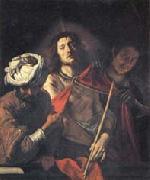 |
Domenico Fetti
|
|
Italian painter ,
Rome 1589 - Venice 1623
was an Italian Baroque painter active mainly in Rome, Mantua and Venice. Born in Rome to a little-known painter, Pietro Fetti, Domenico is said to have apprenticed initially under Ludovico Cigoli, or his pupil Andrea Commodi in Rome from circa 1604-1613. He then worked in Mantua from 1613 to 1622, patronized by the Cardinal, later Duke Ferdinando I Gonzaga. In the Ducal Palace, he painted the Miracle of the Loaves and Fishes. The series of representations of New Testament parables he carried out for his patron's studiolo gave rise to a popular specialty, and he and his studio often repeated his compositions. In August or September 1622, his feuds with some prominent Mantuans led him to move to Venice, which for the first few decades of the seventeenth century had persisted in sponsoring Mannerist styles (epitomized by Palma the Younger and the successors of Tintoretto and Veronese). Into this mix, in the 1620s?C30s, three "foreigners"??Fetti and his younger contemporaries Bernardo Strozzi and Jan Lys??breathed the first influences of Roman Baroque style. They adapted some of the rich coloration of Venice but adapted it to Caravaggio-influenced realism and monumentality. In Venice where he remained despite pleas from the Duke to return to Mantua, Fetti changed his style: his formalised painting style became more painterly and colourful. |
 |
Domenico Feti
|
|
1589-1625
Italian
Domenico Feti Locations
Italian painter. Court painter to the Gonzaga family in Mantua, Feti was influenced by the chiaroscuro technique of Caravaggio. His later works, such as Melancholia (Louvre), belong, in their use of color, to the Venetian tradition. |
 |
Defendente Ferrari
|
|
(c. 1480/1485 - c. 1540) was an Italian painter active in Piedmont.
Ferrari was born at Chivasso, near Turin, and worked in the workshop of Giovanni Martino Spanzotti.
He met considerable success as a painter of polyptychs and altarpieces, characterized by a highly decorative style inspired by Northern Europe masters.
|
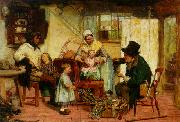 |
David Henry Friston
|
|
(1820 - 1906) was a British illustrator and figure painter in the Victorian Era. He is best remembered as the creator of the first illustrations of Sherlock Holmes in 1887, as well as his illustrations of the controversial female vampire story Carmilla (1872). He is also remembered for his illustrations accompanying reviews of Gilbert and Sullivan operas and plays of W. S. Gilbert in The Illustrated London News and the Illustrated Sporting and Dramatic News in the 1870s and 1880s.
|
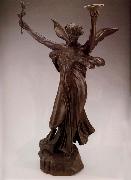 |
Daniel Chester French
|
|
American Neoclassical Sculptor, 1850-1931.was an American sculptor. His best-known work is the sculpture of a seated Abraham Lincoln at the Lincoln Memorial in Washington, D.C. French was born in Exeter, New Hampshire, to Henry Flagg French, a lawyer, Assistant US Treasury Secretary and author of a book that described the French drain. Daniel Chester French was a neighbor and friend of Ralph Waldo Emerson, and the Alcott family. His decision to pursue sculpting was influenced by Louisa May Alcott's sister May Alcott. After a year at the Massachusetts Institute of Technology, French worked on his father's farm. While visiting relatives in Brooklyn, New York City, he spent a month in the studio of John Quincy Adams Ward, then began to work on commissions, and at the age of twenty-three received from the town of Concord, Massachusetts, an order for his well-known statue The Minute Man, which was unveiled April 19, 1875 on the centenary of the Battle of Lexington and Concord. Previously French had gone to Florence, Italy, where he spent a year working with sculptor Thomas Ball. In 1917, he designed the Pulitzer Prize gold medal presented to laureates. In collaboration with Edward Clark Potter he modelled the George Washington statue, presented to France by the Daughters of the American Revolution; the General Grant in Fairmount Park, Philadelphia, and the General Joseph Hooker statue in Boston. In 1893, French was a founding member of the National Sculpture Society, and he became a member of the American Academy of Arts and Sciences. French also became a member of the National Academy of Design (1901), the American Academy of Arts and Letters, the National Sculpture Society, the Architectural League, and the Accademia di San Luca, of Rome. French was one of many sculptors who frequently employed Audrey Munson as a model. |
 |
COSSA, Francesco del
|
|
Italian Early Renaissance Painter, ca.1435-1477
Italian painter. Together with Cosimo Tura and Ercole de' Roberti, Cossa was one of the most important painters working in Ferrara and Bologna in the second half of the 15th century. With them he shared an expressive use of line and solidity of form, but he also had a gift for decorative and anecdotal scenes, most evident in the frescoes in the Palazzo Schifanoia, Ferrara. |
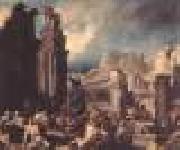 |
COLLANTES, Francisco
|
|
Spanish Baroque Era Painter, 1599-1656
Spanish painter. He was probably a pupil of Vicente Carducho, but there is nothing to support this idea. His evident familiarity with contemporary Italian art indicates that he visited Rome and Naples, and this might explain the absence of documentation on him in Spain. Collantes enjoyed considerable prestige, and his paintings were acquired in 1634 for the decoration of the Buen Retiro Palace in Madrid; some of them may have been specially painted for this setting. His name appears frequently in the inventories of collectors in Madrid throughout the 17th century. It is impossible to date Collantes's undated paintings with any accuracy. However, his work shows two very clear and different lines of development. His canvases of large, intensely naturalistic figures, with tenebrist lighting effects , are close in style to those of Jusepe Ribera. In them the intense, energetic figures are sometimes set against landscape backgrounds, for example in St Humphrey (1645-50; Madrid, Prado) and St John the Baptist , but, still following Ribera, the naturalistic elements are emphasized. He also specialized in landscapes and in biblical or mythological subjects, compositions with minute figures set against wide landscapes or architecture with strong light effects. These are the works for which he is best known and which are the most important, since he was one of the few landscape painters in Spain in the 17th century. |
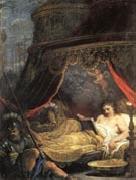 |
Ciro Ferri
|
|
Italian Baroque Era Painter and Sculptor , ca.1634-1689
was an Italian Baroque sculptor and painter, the chief pupil and successor of Pietro da Cortona. He was born in Rome, where he began working under Cortona and with a team of artists in the extensive fresco decorations of the Quirinal Palace (1656-1659). He collaborated with Cortona and completed for him the extensive frescoed ceilings and other internal decorations begun in the Pitti Palace, Florence (1659-1665). His independent masterpiece is considered an extensive series of scriptural frescoes in the church of Basilica di Santa Maria Maggiore (Bergamo). In addition, also well known is his an altarpiece of St Ambrose Healing the Sick in the church of Sant'Ambrogio della Massima in Rome. In 1670, he began the painting of the cupola of Sant'Agnese in Agone in central Rome, in a style recalling of Lanfranco's work in the dome of Sant'Andrea della Valle; but died before it was completed in 1693 by his successor Sebastiano Corbellini. He executed also a large amount of miscellaneous designs, such as etchings and frontispieces for books; and served as an architect as well. Ferri was appointed to direct the Florentine students in Rome, and Gabbiani was one of his leading pupils. As regards style, Ferri ranks as chief of the grand manner of Cortona, as opposed to the more sober and spare style promulgated by Andrea Sacchi, and continued by Carlo Maratta and others. |
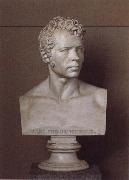 |
Christian Friedrich Tieck
|
|
1776-1851 Berlin,was a German sculptor and a brother of Ludwig Tieck. Tieck was born in Berlin, where he also died. He was taught by Johann Gottfried Schadow. Based on a concept by Karl Friedrich Schinkel, Tieck created the tomb of General Gerhard von Scharnhorst at Berlin's Invalidenfriedhof in 1822. He also created a bust of Wilhelm Heinrich Wackenroder and a lion made of bronze after a model by Christian Daniel Rauch. |
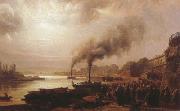 |
Christian Friedrich Gille
|
|
1805-1899
German painter, engraver and lithographer. Between 1825 and 1833 he studied engraving under Johann Gottfried Abraham Frenzel, lithography under Louis Z?llner and painting under Johan Christian Dahl at the Hochschule f?r Bildende K?nste, Dresden. Dahl encouraged in Gille an appreciation for the natural formations and changing conditions of light that had inspired Dahl's friend and mentor, the Romantic painter Caspar David Friedrich. Gille, however, did not adopt Friedrich's tendency to find mystical significance in these phenomena. Gille's prints are highly descriptive in style and include Saxon landscapes, genre scenes, animal studies and portraits of celebrated men. His paintings and sketches, in oils, watercolour and pen and brown ink, were mostly of landscapes, many with animal staffage. |
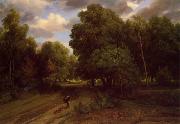 |
Charles-Francois Daubigny
|
|
French Barbizon School Painter, 1817-1878
was one of the painters of the Barbizon school, and is considered an important precursor of Impressionism. Daubigny was born into a family of painters and was taught the art by his father Edmond François Daubigny and his uncle, miniaturist Pierre Daubigny. Initially Daubigny painted in a traditional style, but this changed after 1843 when he settled in Barbizon to work outside in nature. Even more important was his meeting with Camille Corot in 1852 in Optevoz (Is??re). On his famous boat Botin, which he had turned into a studio, he painted along the Seine and Oise, often in the region around Auvers. From 1852 onward he came under the influence of Gustave Courbet. In 1866 Daubigny visited England, eventually returning because of the Franco-Prussian war in 1870. In London he met Claude Monet, and together they left for the Netherlands. Back in Auvers, he met Paul Cezanne, another important impressionist. |
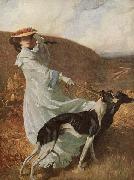 |
Charles Wellington Furse
|
|
(January 13, 1868 - October 16, 1904) was an English painter.
He was born at Staines, the son of the Rev. C. W. Furse, archdeacon of Westminster, and rector of St John's, Smith Square and descended collaterally from Sir Joshua Reynolds; and in his short span of life achieved such rare excellence as a portrait and figure painter that he forms an important link in the chain of British portraiture which extends from the time when Van Dyck was called to the court of Charles I into the 20th century.
His talent was precocious; at the age of seven he gave indications of it in a number of drawings illustrating Scott's novels. He entered the Slade School in 1884, winning the Slade scholarship in the following year, and completed his education at Julians Atelier in Paris. Hard worker as he was, his activity was frequently interrupted by spells of illness, for he had developed signs of consumption when he was still attending the Slade school. An important canvas called Cain was his first contribution (1888) to the Royal Academy, to the associateship of which he was elected in the year of his death. For some years before he had been a staunch supporter of the New English Art Club, to the exhibitions of which he was a regular contributor.
In October 1900 he married Katharine Symonds, the daughter of John Addington Symonds. She later became known as Dame Katharine Furse. The couple had 2 sons. His fondness for sport and of an open-air life found expression in his art and introduced a new, fresh and vigorous note into portraiture. There is never a suggestion of the studio or of the fatiguing pose in his portraits. The sitters appear unconscious of being painted, and are generally seen in the pursuit of their favourite outdoor sport or pastime, in the full enjoyment of life. Such are the Diana of the Uplands, the Lord Roberts and The Return from the Ride at the Tate Gallery; the four children in the Cubbing with the York and Ainsty, The Lilac Gown, Mr. and Mrs. Oliver Fishing and the portraits of Lord Charles Beresford and William Johnson Cory.
Most of these pictures, and indeed nearly all the work completed in the few years of Furse's activity, show a pronounced decorative tendency. His sense of space, composition and decorative design can best be judged by his admirable mural decorations for Liverpool town hall, executed between 1899 and 1902. A memorial exhibition of Furse's paintings and sketches was held at the Burlington Fine Arts Club in 1906.
|
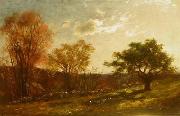 |
Charles Furneaux
|
|
(1835 - 1913) was born in Boston and became a drawing instructor in that area. For many years he lived in the town of Melrose, Massachusetts. In 1880, Furneaux moved to Hawaii, where he cultivated the friendship King Kalakaua and other members of the Hawaiian royal family, from whom he later received several commissions. In the late 1880's,he was commissioned in Honolulu by Alexander Joy Cartwright, widely credited as the "father of baseball" and another dear friend of King Kalakaua, to paint the only oil portrait of his 72 year life. While living in Honolulu he taught at the private schools Punahou and St. Albans (now known as Iolani School). In 1885, he received the order of Chevalier of Kapiolani from King Kalakaua in 'recognition of his services in advancing Hawaiian art'. He died in Hawaii in 1913.
His reputation is mainly based on the paintings he executed in Hawaii, especially those of erupting volcanoes. The Bishop Museum (Honolulu), the Brooklyn Museum, the Honolulu Academy of Arts, Iolani Palace (Honolulu) and Mount Holyoke College Art Museum (South Hadley, Massachusetts) are among the public collections holding works by Charles Furneaux.
|
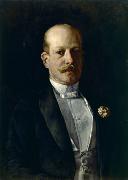 |
Charles Frederic Ulrich
|
|
Charles Frederic Ulrich (1858, New York City - 1908, Berlin), was an American painter.
According to the RKD he worked in the Netherlands ca. 1890. He attended the Royal Academy in Munich, Germany, as did William Merritt Chase, who like him, was influenced by Dutch Golden Age painting and who has been documented as painting his portrait. He was discovered by Thomas B. Clarke, a lace and linen manufacturer in New York who became a collector of contemporary American art. Ulrich painted his portrait in gratitude after his painting "In the Land of Promise, Castle Garden" was shown at the National Academy of Design, where it won the National Academy's first Thomas B. Clarke Prize for Best American Figure Composition. |
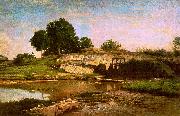 |
Charles Francois Daubigny
|
|
b Feb. 15, 1817, Paris, France
d.Feb. 19, 1878, Paris French
78, French landscape painter. He went to Italy early in life and later studied in Paris with Paul Delaroche. Although usually classed with the Barbizon school, he never lived in Barbizon. His last 30 years were spent largely in his houseboat on the Seine and the Oise, and he is best known for his pictures of the banks of those rivers. He was particularly successful in his atmospheric depiction of dawn, twilight, and moonlight. His later pictures are handled with great breadth. Monet and Boudin were especially attentive to his work. Daubigny is well represented in the Louvre, the Mesdag Museum (The Hague), the National Gallery (London), and the Metropolitan Museum. Characteristic are his Return of the Flock??Moonlight, Banks of the Oise, and Moonlight. His son Karl Pierre Daubigny, 1846?C86, painted in his father manner. |
 |
Charles Ferdinand Wimar
|
|
German-born American Painter
b.1828 d.1862
was a painter of Western Native Americans and buffaloes. Born in Siegenburg, Germany, came to America at the age of 15, settled with his parents in St. Louis, Missouri. In 1846 he began studying painting with Leon Pomarede and went with his master on a trip up the Mississippi River. In 1852 he went to the D??sseldorf Academy to study with Emanuel Leutze. Wimar returned to St. Louis in 1856. He primarily occupied himself with the themes of Indian life, buffalo herds, life in the Great Plains, the theme of the wagon trains. He made three trips to the headwaters of the Mississippi. |
 |
Charles de La Fosse
|
|
(June 16, 1636 - December 13, 1716), French painter, was born in Paris.
He was one of the most noted and least servile pupils of Le Brun, under whose direction he shared in the chief of the great decorative works undertaken in the reign of Louis XIV. Leaving France in 1662, he spent two years in Rome and three in Venice. The influence of his prolonged studies of Veronese is evident in his "Finding of Moses" (Louvre), an in his "Rape of Proserpine" (Louvre), which he presented to the Royal Academy as his diploma picture in 1673. He was at once named assistant professor, and in 1674 the full responsibilities of the office devolved on him, but his engagements did not prevent his accepting in 1689 the invitation of Lord Montagu to decorate Montagu House.
He visited London twice, remaining on the second occasionetogether with Rousseau and Monnoyer more than two years. William III vainly strove to detain him in England by the proposal that he should decorate Hampton Court, for Le Brun was dead, and Mansart pressed La Fosse to return to Paris to take in hand the cupola of Les Invalides. The decorations of Montagu House are destroyed, those of Versailles are restored, and the dome of the Invalides (engraved, Picart and Cochin) is now the only work existing which gives a full measure of his talent. During his latter years La Fosse executed many other important decorations in public buildings and private houses, notably in that of Crozat, under whose roof he died on 13 December 1716.
This article incorporates text from a publication now in the public domain: Chisholm, Hugh, ed (1911). Encyclopædia Britannica (11th ed.). Cambridge University Press.
|
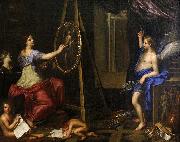 |
Charles Alphonse du Fresnoy
|
|
(1611C1665), French painter and writer on his art, was born in Paris, son of an apothecary.
He was destined for the medical profession, and well educated in Latin and Greek; but, having a natural propensity for the fine arts, he would not apply to his intended vocation, and was allowed to learn the rudiments of design under Perrier and Vouet. At the age of twenty-one he went off to Rome, with no resources; he drew ruins and architectural subjects.
After two years thus spent he re-encountered his old fellow-student Pierre Mignard, and by his aid obtained some amelioration of his professional prospects. He studied Raphael and the antique, went in 1633 to Venice, and in 1656 returned to France. During two years he was now employed in painting altar-pieces in the château du Raincy, landscapes, etc. His death was caused by an attack of apoplexy followed by palsy; he expired at Villiers-le-Bel, near Paris. He never married.
His pictorial works are few; they are correct in drawing, with something of the Caracci in design, and of Titian in colouring, but wanting fire and expression, and insufficient to keep his name in any eminent repute.
He is remembered now almost entirely as a writer rather than painter. His Latin poem, De arte graphica, was written during his Italian sojourn, and embodied his observations on the art of painting; it may be termed a critical treatise on the practice of the art, with general advice to students. The precepts are sound according to the standard of his time; the poetical merits slender enough. The Latin style is formed chiefly on Lucretius and Horace. |
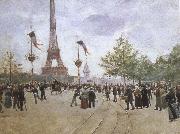 |
cesar franck
|
|
For playwright Frances Burney (1776 C 1828), niece of novelist Fanny Burney Madame d'Arblay 1752-1840, see Frances Burney (1776?C1828)
|
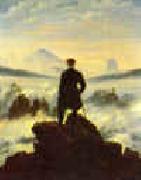 |
Caspar David Friedrich
|
|
1774-1840 Caspar David Friedrich Locations German painter, studied art at Copenhagen, and in 1798 settled in Dresden. Friedrich painted chiefly landscapes and seascapes, with and without figures, architectural pictures, including a few of Dresden, and some religious subjects. Religious feeling and symbolism permeate his œuvre, of which the seascape with figures, Die Lebensstufen, is a characteristic example. He possessed considerable power to convey mood in landscape. Almost forgotten in the 19th c. and early 20th c., interest in his work increased considerably in the mid-20th c. He is hardly represented in Britain, but an exhibition of 112 of his pictures at the Tate Gallery in 1972 attracted much attention. F. G. Kersting was a friend of Friedrich. |
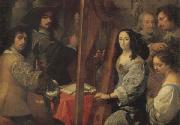 |
Carlo Francesco Nuvolone
|
|
Italian Baroque Era Painter, 1609-1662
was an Italian painter of the Baroque period, active mainly in Lombardy. He was born in Milan to an Cremonese father and mannerist painter, Panfilo Nuvolone. After working with his father, he studied under Giovanni Battista Crespi (il Cerano) in the Accademia Ambrosiana in Milan. In that studio he would have encountered Daniele Crespi and Giulio Cesare Procaccini. Of particular interest is his depiction of himself as a painter surrounded by his family of artists |
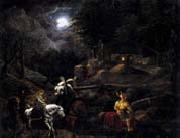 |
Carl Philipp Fohr
|
|
German, 1795-1818,German painter and draughtsman. His first drawing lessons, from the age of 13, were from Friedrich Rottmann (1768-1816), the father of the painter Carl Rottmann. In 1810 the Darmstadt Court Councillor, Georg Wilhelm Issel, discovered Fohr sketching at Stift Neuberg near Heidelberg and, the following year, invited him to Darmstadt and provided encouragement and financial support. From 1813 Fohr carried out commissions for Grand Duchess Wilhelmina of Hesse, for whom he produced a Sketchbook of the Neckar Region, a collection of views and historical subjects (30 watercolours; 1813-14) and also a Baden Sketchbook (30 watercolours, 1814-15; both Darmstadt, Hess. Landesmus.). These far surpassed the usual level attained in this genre in their sharpness of detail, delicacy of colour and pictorial inventiveness. The Crown Princess granted him an annual pension of 500 guilders. From July 1815 to May 1816, Fohr was a student of landscape painting at the Kunstakademie in Munich. |
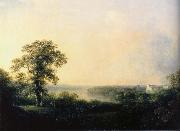 |
Carl Johan Fahlcrantz
|
|
Swedish, 1774-1861, Swedish painter. He began his artistic training in Stockholm as a pupil of the theatre painters J. G. Brusell and E. Limnell (1764-1861). He also studied under the French landscape painter Louis Belanger (1736-1816). In 1805 he was awarded a scholarship to go to Italy, but he preferred to use it to travel within Sweden, as this corresponded more with his interest in painting his native landscape in a National Romantic style. Fahlcrantz settled permanently in Sweden, never travelling outside the Nordic countries. In 1819 he became a professor at the Royal Academy of Arts in Stockholm and in the 1820s Karl XIV commissioned a series of major works from him. Oscar I followed suit, as did numerous other buyers inside and outside Sweden. In this way, Fahlcrantz's paintings were distributed as far as Denmark, Bavaria, Russia and America. |
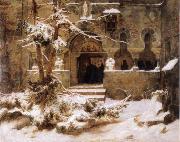 |
Carl Friedrich Lessing
|
|
German Painter, 1808-1880,Painter, great-nephew of GOTTHOLD EPHRAIM LESSING. He studied architecture in Berlin at the Kenigliche Bau-Akademie under Karl Friedrich Schinkel, before transferring to the Kunstakademie, where he became a pupil of Wilhelm Schadow in 1825. The next year Lessing followed Schadow to Desseldorf, where the latter had been appointed Director of the Kunstakademie. Almost to the end of his career Lessing was to follow Schadow's rules for a standard series of procedures in the production of a finished work: compositional sketch, oil study, detailed model study, cartoon and underdrawing for the final painting. Without an official position, Lessing worked at the Desseldorf Akademie until 1858 |
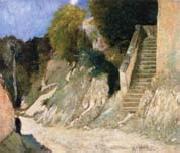 |
Carl Fredrik Hill
|
|
Swedish Painter, 1849-1911,Swedish painter and draughtsman. He grew up in the university city of Lund, where his father was a mathematics professor. Despite severe opposition from his father, he studied landscape painting at the Konstakademi in Stockholm (1871-2), under Johan Edvard Bergh and Per Daniel Holm (1835-1903). He also frequently copied Dutch Old Masters, particularly Jacob van Ruisdael. After seeing the work that Alfred Wahlberg had sent home from Paris, Hill began to abandon his initial approach to form and colour, and he left for Paris in November 1873. His most important experience there was his encounter with the painting of Jean-Baptiste-Camille Corot: 'Corot has discovered a new world, because he has discovered a new way of looking at the old', he wrote in a letter. Other contemporary French painters Hill admired were Alexandre-Gabriel Decamps, Charles-Fran?ois Daubigny, Jean-Franeois Millet and Theodore Rousseau. From Courbet he learnt how to use colour to suggest the surface texture of stone quarries and gravel hills. In Barbizon in 1874 and 1875 Hill met the Hungarian painters Laszlo Pael and Mihaly von Muncacsy. His paintings of this time, for example Autumn Landscape, Evening: Fontainebleau (1875; Malm?, Kstmus.), are characterized by their dark 'luminarism' and their debt to Corot's later works. |
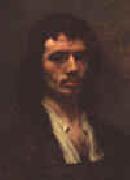 |
Carel Fabritus
|
|
1622-1654
Dutch
Carel Fabritus Locations
Painter. His oeuvre consists of a scant dozen paintings, since research has rigorously discounted many previously attributed works. These few paintings, however, document the painter unique development within his brief 12-year career. He is often mentioned as being the link between Rembrandt and the Delft school, particularly Pieter de Hooch and Jan Vermeer, whose depiction of light owes much to Fabritius late works in which his use of cool silvery colours to define forms in space marks a radical departure from Rembrandt use of chiaroscuro. |
|

